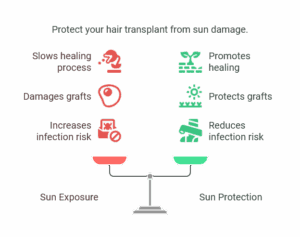A lot of people suffering from hair loss decide to take some of the vacation days they have left at work to get a hair transplant in Istanbul, and that is usually during the summer months. Unfortunately, the intense heat and ultraviolet radiation can damage the hair follicles before they’ve had time to fully heal and strengthen.
That’s why patients are advised to avoid sun exposure after hair restoration procedures to minimize the risk of any issues. We will look at why this can be problematic, how to avoid it, and what to do to ensure the best results.
Is Sun Exposure Bad for a Hair Transplant?
When the skin is exposed to the sun under normal conditions, specialized cells called chromatophores help it develop a darker pigmentation to protect it from the harsh sun rays, which is how people develop a tan.
However, during hair transplant surgery, these cells are damaged or destroyed and need some time to get back to their normal function. That’s why in the days right after the operation, you can experience sun damage, which reduces the survival rates of the transplanted grafts, leading to suboptimal hair growth.
With that in mind, let’s look at the recovery timeline to see when you can get back to your regular activities.

How Long After a Transplant Can I Expose My Head to Direct Sunlight?
The exact timeframe will differ depending on the patient, e.g., someone with really pale skin will have to be careful for a while longer than someone with naturally dark skin. However, undergoing a hair transplant leaves the scalp in a vulnerable state for a while, regardless of skin tone, so most people should avoid sun exposure after a hair transplant for at least three months.
That is the minimum amount of time doctors recommend, and it’s often even longer, up to six months or when the transplanted hair starts growing out much more. It takes time for the protective cells to fully regenerate, and you’ll have to be extra careful until then.
What Are Some Simple Ways to Avoid Sun Exposure?
Of course, it’s impossible to expect people not to leave their house for several months, and even if you’ve had a hair transplant procedure during the darker winter months, you’ll still be in a risky position in a few months when spring comes.
That’s why you need to think about protecting your scalp from the sun. For a start, you should always apply sunscreen when going out, but only after the first two weeks, when it’s safe to use such products on the scalp again.
You can also wear a hat, a loose-fitting option with good coverage of the transplant area, and try to stay in the shade as much as possible. However, before the swelling has gone down and the hair has healed, so up to 10–14 days post-op, you won’t be able to use any protection and should stay inside and only go out in the early morning, late afternoon, or at night.
It can be a bit difficult to get used to, but it’s the only way to keep your new hair safe.
What Happens if I Go Outside When It’s Sunny Right After the Operation?
A typical FUE hair transplant requires 3,000–5,000 grafts, which means the surgeons will have to create thousands of incisions in the scalp. Even with the latest options like the Sapphire FUE or DHI that minimize tissue damage, the deeper layer of cells in the scalp will be affected.
Not only can direct sun exposure after hair transplant operations lead to your head getting sunburnt and cause sweating, which slows down the healing process and can cause infections, but it can also damage the newly transplanted follicles themselves. The fewer the grafts that survive long enough to take root, the less appealing your before & after results will look.
You don’t want all that time and money spent on scheduling a surgery at one of the best clinics with the most experienced doctors to go to waste just because of a few strolls in the summer heat. It really is a big risk factor that can dramatically change the outcome of the procedure.
Be Careful and Protect Your Head
While direct sunlight can negatively impact your hair transplant results, and is one of the main things you want to be careful about during recovery, it’s also not too difficult to avoid. You just have to be a bit extra careful and make a few minor lifestyle changes.
As long as you avoid the midday heat, wear a loose hat, apply some sunscreen, stay in the shade, and don’t spend too much time outside for the first few months, everything will be just fine.

